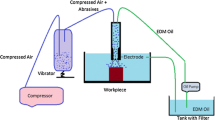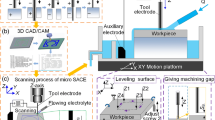Abstract
The discharge craters and recast material are the characteristics of the surface machined by using EDM, which deteriorate the surface quality and other properties such as fatigue strength of the workpiece. In this study, a new combined machining method which utilizes a thin foil as tool electrode and combines EDM and ECM into a single process for slicing workpiece is proposed and investigated through experiments. The method can improve the surface quality by using ECM to remove the discharge craters and recast layer of EDM surface. The advantages of utilizing a foil instead of a wire as tool electrode for slicing the workpiece is that tool vibration can be considerably reduced and the efficiency of electrochemical dissolution increased. The experimental results show that good surface quality can be obtained by eliminating the craters and recast layer of EDM surface without sacrificing the cutting efficiency. Two factors of the combined machining, namely the height and the feed rate of the foil electrode, which have significant influence on the final surface quality are investigated. The taper of the kerf, kerf width, and tool wear are discussed experimentally. The combined machining with a thin foil as tool electrode provides a promising method for workpiece slicing in the future.















Similar content being viewed by others
References
Azam M, Jahanzaib M, Abbasi JA, Abbas M, Wasim A, Hussain S (2016) Parametric analysis of recast layer formation in wire-cut EDM of HSLA steel. Int J Adv Manuf Technol 87(1–4):713–722. https://doi.org/10.1007/s00170-016-8518-3
Zeng Y, Yu Q, Fang X, Xu K, Li H, Qu N (2015) Wire electrochemical machining with monodirectional traveling wire. Int J Adv Manuf Technol 78(5–8):1251–1257. https://doi.org/10.1007/s00170-014-6745-z
Nguyen MD, Rahman M, San Wong Y (2012) Simultaneous micro-EDM and micro-ECM in low-resistivity deionized water. Int J Mach Tools Manuf 54:55–65. https://doi.org/10.1016/j.ijmachtools.2011.11.005
Nguyen MD, Rahman M, San Wong Y (2013) Transitions of micro-EDM/SEDCM/micro-ECM milling in low-resistivity deionized water. Int J Mach Tools Manuf 69:48–56. https://doi.org/10.1016/j.ijmachtools.2013.03.008
Nguyen MD, Rahman M, San Wong Y (2013) Modeling of radial gap formed by material dissolution in simultaneous micro-EDM and micro-ECM drilling using deionized water. Int J Mach Tools Manuf 66:95–101. https://doi.org/10.1016/j.ijmachtools.2012.12.001
Zhang Y, Xu ZY, Zhu D, Qu NS, Zhu Y (2016) Drilling of film cooling holes by a EDM/ECM in situ combined process using internal and side flushing of tubular electrode. Int J Adv Manuf Technol 83(1–4):505–517. https://doi.org/10.1007/s00170-015-7575-3
Zhang Y, Xu ZY, Zhu Y, Zhu D (2016) Effect of tube-electrode inner structure on machining performance in tube-electrode high-speed electrochemical discharge drilling. J Mater Process Technol 231:38–49. https://doi.org/10.1016/j.jmatprotec.2015.12.012
Zhang Y, Xu Z, Zhu D, Xing J (2015) Tube electrode high-speed electrochemical discharge drilling using low-conductivity salt solution. Int J Mach Tool Manu 92:10–18. https://doi.org/10.1016/j.ijmachtools.2015.02.011
Xu ZY, Zhang Y, Ding F, Wang F (2018) An electrochemical discharge drilling method of small deep holes. Int J Adv Manuf Technol 95(5–8):3037–3044. https://doi.org/10.1007/s00170-017-1355-1
Zhang Y, Wang C, Wang Y, Ni Q, Ji L (2019) Geometric accuracy improvement by using electrochemical reaming with a helical tube electrode as post-processing for EDM. Materials 12(21):18. https://doi.org/10.3390/ma12213564
Han Y, Liu Z, Cao Z, Kong L, Qiu M (2018) Mechanism study of the combined process of electrical discharge machining ablation and electrochemical machining in aerosol dielectric. J Mater Process Technol 254:221–228. https://doi.org/10.1016/j.jmatprotec.2017.11.025
Wu X (2019) Study of removing the recast layer by electrochemical dissolution with wire low feedrate in WEDM. Int J Adv Manuf Technol 105(1):1143–1156. https://doi.org/10.1007/s00170-019-04313-w
Wu X, Li S, Jia Z, Xin B, Yin X (2019) Using WECM to remove the recast layer and reduce the surface roughness of WEDM surface. J Mater Process Technol 268:140–148. https://doi.org/10.1016/j.jmatprotec.2019.01.016
Wu X, Li S, Zhao W, Tang L, Li Z (2019) Experiment investigation of using wire electrochemical machining in deionized water to reduce the wire electrical discharge machining surface roughness. Int J Adv Manuf Technol 102(1):343–353. https://doi.org/10.1007/s00170-018-3196-y
Zhao Y, Kunieda M, Abe K (2013) Experimental investigations into EDM behaviors of single crystal silicon carbide. Procedia CIRP 6:135–139. https://doi.org/10.1016/j.procir.2013.03.064
Zhao Y, Kunieda M, Abe K (2014) Study of EDM cutting of single crystal silicon carbide. Precis Eng 38(1):92–99. https://doi.org/10.1016/j.precisioneng.2013.07.008
Zhao Y, Kunieda M, Abe K (2016) Comparison on foil EDM characteristics of single crystal SiC between in deionized water and in EDM oil. Int J Adv Manuf Technol 86(9–12):2905–2912. https://doi.org/10.1007/s00170-016-8412-z
Flaño O, Zhao Y, Kunieda M, Abe K (2017) Approaches for improvement of EDM cutting performance of SiC with foil electrode. Precis Eng 49:33–40. https://doi.org/10.1016/j.precisioneng.2017.01.007
Zhao Y, Kunieda M, Abe K (2018) A novel technique for slicing SiC ingots by EDM utilizing a running ultra-thin foil tool electrode. Precis Eng 52:84–93. https://doi.org/10.1016/j.precisioneng.2017.11.012
Ho K, Newman S (2003) State of the art electrical discharge machining (EDM). Int J Mach Tools Manuf 43(13):1287–1300. https://doi.org/10.1016/S0890-6955(03)00162-7
Funding
The Scientific Research Program is funded by the Shaanxi Provincial Education Department (Program No. 19JS037) and Natural Science Basic Research Program of Shaanxi (Program No. 2020JM-567).
Author information
Authors and Affiliations
Corresponding author
Additional information
Publisher’s note
Springer Nature remains neutral with regard to jurisdictional claims in published maps and institutional affiliations.
Rights and permissions
About this article
Cite this article
Wu, X. Experimental investigation of a new method combining EDM and ECM to cut the workpiece with foil electrode. Int J Adv Manuf Technol 110, 705–715 (2020). https://doi.org/10.1007/s00170-020-05923-5
Received:
Accepted:
Published:
Issue Date:
DOI: https://doi.org/10.1007/s00170-020-05923-5




